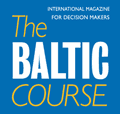
All rights reserved.
You may not copy, reproduce, republish, or otherwise use www.baltic-course.com content
in any way except for your own personal, non-commercial use.
Any other use of content requires the hyperlink to www.baltic-course.com.

Printed: 20.04.2024.
 PrintEU’s Economy & Finance Minister’s idea becomes a reality by mid-2019
PrintEU’s Economy & Finance Minister’s idea becomes a reality by mid-2019
 |
|---|
The plan of deepening the Economic and Monetary Union (EMU) has noble aims: more jobs, growth, investment, social fairness and macroeconomic stability in the member states. The single currency offers protection and opportunities to Europeans; strong and stable euro area is essential both for its members and for the whole EU.
The growth in the EU is apparent: unemployment is at its lowest level since 2008, economic sentiment is at its highest since 2000, Europeans has shown the highest level of support for the single currency since the introduction of euro more than two decades ago. This provides a window of opportunity for deepening Europe's Economic and Monetary Union.
The
new measures are a continuation of Union’s previous measures. There have been
important institutional reforms to strengthen EMU during 2015-17: proposals in the Five Presidents'
Report of June 2015; Reflection Papers on the Deepening of the
Economic and Monetary Union, and the state-of-art of the Future of EU
Finances made in spring 2017, to name a few. However, the final
architecture needs completion and “final touch”: hence present roadmap reflecting
changes and eradicating challenges.
Commenting
on the roadmap, Commission President Juncker said that present robust economic growth after years of crises, encourages the EU member
states to move ahead to ensure that the Union’s economic and monetary policy
becomes more united, efficient and democratic, “working for all citizens”. There
is no better time to fix the roof than when the sun is shining, he added. See: http://europa.eu/rapid/press-release_IP-17-5005_en.htm?locale=en
Present
package also includes ideas presented by the European Parliament and French
President Emmanuel Macron in his Sorbonne speech in
September; they will be discussed at the Euro Summit on
15 December 2017 where EU leaders will discuss next steps, as well as at a
special meeting planned for the end of June 2018 with a view to reach concrete
decisions.
Roadmap’s four main initiatives
All reforms initiated so far by the EU, have been driven by the
need to combine solidarity and responsibility at all levels;
but that was not enough. When it comes to economic performance and citizens’
confidence in the single currency, some new measures are needed. For example,
according to recent European Flash
Eurobarometer on the euro area, only about 64% of respondents say the euro is a good
thing for their countries.
The
following are four main initiatives:
1.
Establishing a European Monetary
Fund (EMF), connected with the well-established structure of the
European Stability Mechanism (ESM). In recent years, the ESM has played a
decisive role in safeguarding the stability of the euro area by assisting the states
to regain or maintain access to sovereign bond markets. The EMF will preserve current
financial and institutional structures, including the role of national
parliaments. It would thus continue to assist euro area states in financial
distress. In addition, the EMF would provide the common backstop to the Single
Resolution Fund and act as a last resort lender in order to facilitate the
orderly resolution of distressed banks. More rapid decision-making in cases of
urgency and more direct involvement in the management of financial assistance
programmes are also foreseen. Over time, the EMF could also develop new
financial instruments, for instance to support a possible stabilisation
function. The European Parliament and the Council are expected to adopt this
proposal by mid-2019.
2.
Integrating the Treaty on Stability,
Coordination and Governance into the Union’s basic law, taking into account flexibility envisaged
in the Stability and Growth Pact.
Already in 2012, the 25 signatory EU states legally committed to
incorporate the substance of that Treaty into Union law five years after its
entry into force, which corresponds to 1 January 2018.
This
proposal incorporates into Union law the main elements of the Treaty in order
to support sound fiscal frameworks at national level and is fully in line with
existing rules defined in the EU’s primary and
secondary legislation. The European Parliament and the Council are
invited to adopt this proposal by mid-2019.
3.
Measures for new budgetary instruments for a stable euro area; they set certain budgetary
functions essential to strengthen member states public finances presently and
in future. These measures include the following EU’s specific functions: a) to support
states in structural reforms through a reform delivery tool and technical
support at the request of the states; b) provide a dedicated
convergence facility for other EU states on their way to joining the euro;
c) assisting in supporting the Banking Union, through the EMF/ESM, to be
agreed by mid-2018 and made operational by 2019; and d) creating a stabilisation
function in order to protect investments in the event of large
asymmetric shocks.
The
Commission will present the necessary initiatives in May 2018 in the context of
its proposals for the post-2020
Multiannual Financial Framework. The European Parliament and the Council
are invited to adopt these proposals by mid-2019.
During
2018-20, the Commission proposes strengthening the Structural Reform Support
Programme, by doubling the funding available for technical support
activities, thus reaching €300 million up to 2020. The Commission is also
proposing to test the new reform delivery tool in a pilot phase with some targeted
changes to the Common Provisions Regulation governing the European Structural
and Investment Funds (ESIF) in order to extend the possibilities to use part of
their performance reserve in support agreed reforms. The European Parliament
and the Council are invited to adopt these latter two proposals during 2018.
4.
A Communication spelling out the possible functions of a European
Minister of Economy and Finance who could serve as Vice-President of
the Commission and chair the Eurogroup, as is possible under the current EU
Treaties. By bringing together existing responsibilities and available
expertise, this new position would strengthen the coherence, efficiency,
transparency and democratic accountability of economic policy-making for the EU
and the euro area, in full respect of national competences. Reaching a common
understanding on the role of the Minister by mid-2019 would allow setting it up
as part of the formation of the next Commission. The Eurogroup could then also
decide to elect the Minister as its President for two consecutive terms in
order to align both mandates.
EU leaders’ agenda: supporting education and culture
The next 18 months should also be used to take necessary steps, as agreed in the “Leaders' Agenda” in October 2017, concerning education and culture issues.
See more in: http://www.consilium.europa.eu/en/policies/tallinn-leaders-agenda/
During September-October 2017, the EU leaders discussed European future: e.g. at the end of September, the EU leaders held mandated European Council’s President D. Tusk to translate reflections and ideas on future of Europe into a concrete work programme facing most important challenges ahead.
With this objective in mind, Tusk was holding
bilateral consultations with all EU leaders in the run-up to the European
Council on 19-20 October 2017. The Leaders' Agenda was built on the ideas that
President Tusk presented in his letter ahead of the Tallinn meeting. Besides,
on 13 October 2017, President of the European Council Donald Tusk discussed the
leaders’ agenda with the Prime Ministers of the Visegrad Group (V4): PM of Poland: Beata Szydlo, PM of Hungary: Viktor
Orban, PM Czech Republic: Bohuslav Sobotka, PM of Slovakia: Robert
Fico.
Thus,
the EU leaders’ agenda for education and culture included some concrete
ideas:
=
Encourage the creation of a network of European Universities from different EU
states, with integrated study programmes and curricula that enable students to
study abroad and attend classes in at least two languages.
=
Promote mutual recognition of secondary education diplomas and the development
of new curricula allowing for exchanges across European high school systems.
=
Promote multilingualism by aiming at all students speaking at least two
additional European languages.
=
Launch a reflection on the Future of Learning to respond to future trends and
the digital revolution, including Artificial Intelligence.
=
Enhance the ability of creative industries to access startup capital and
financing, etc.
See more in “Education and culture: leaders’
agenda” in:
http://www.consilium.europa.eu/media/31544/en_leaders-agenda-note-on-education-and-culture.pdf
More information on the following websites: = Deepening
Europe's Economic and Monetary Union – Questions and Answers; = Factsheets on
Deepening Europe's Economic and Monetary Union; = Flash Eurobarometer
458 on the euro area, December 2017; = Communication on
further steps towards completing the Economic and Monetary Union; = Proposal for the
establishment of a European Monetary Fund anchored in the Union legal framework;
= Proposal to
integrate the substance of the Treaty on Stability, Coordination and Governance
into the Union legal framework, taking into account the appropriate flexibility
built into the Stability and Growth Pact and identified by the Commission since
January 2015; = Communication on
new budgetary instruments for a stable euro area within the Union framework;
= Targeted changes
in the Common Provisions Regulation to mobilise funds in support of national
reforms; = An amendment to
strengthen the Structural Reform Support Programme; = Communication on
a European Minister of Economy and Finance; = President
Juncker's State of the Union address 2017; = Reflection Paper
on Deepening the Economic and Monetary Union; = Reflection Paper
on the Future of EU Finances; = The Five
Presidents' Report; = The White Paper
on the Future of Europe.
References: Commission press release
“Commission sets out roadmap for deepening Europe's Economic and Monetary
Union”, Brussels,
6 December 2017. In:
http://europa.eu/rapid/press-release_IP-17-5005_en.htm?locale=en.
Latvian version: http://europa.eu/rapid/press-release_IP-17-5005_lv.htm;
Lithuanian version: http://europa.eu/rapid/press-release_IP-17-5005_lt.htm;
Estonian version: http://europa.eu/rapid/press-release_IP-17-5005_et.htm